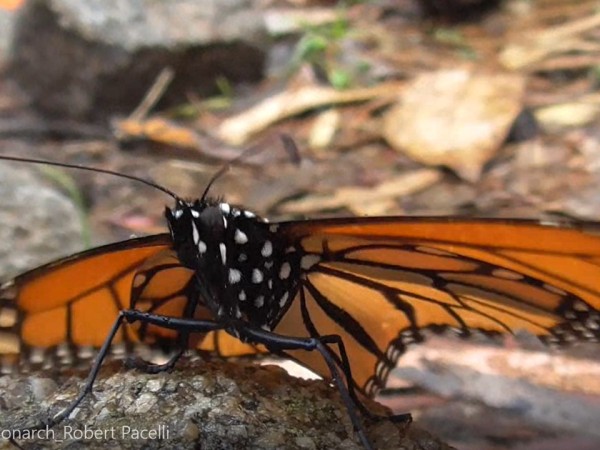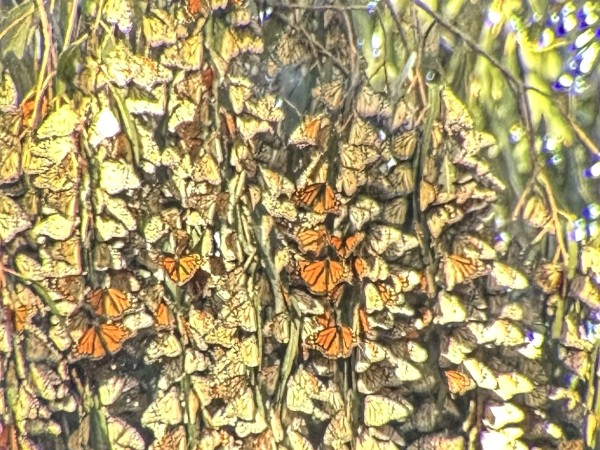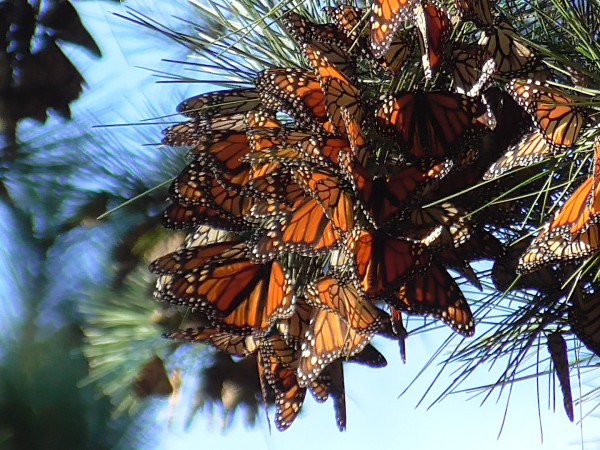Letter From Gail Morris: Western Monarch Fall 2022 Report #6
Published: 12/13/2022
Dear Western Monarch Friends,
A blustery winter storm took aim on California and reached its arms across the West this week. The region was covered with a blanket of colder temperatures, rain and mountain snow. Monarchs responded by nestling safely in their protective trees deep within many groves. The estimate of overwintering counts along the California coast are hopeful but there are also pockets of monarchs in other locations throughout the Southwest.
Overwintering Monarch Update
Hopeful news broke this week with the Xerces Society Western Monarch Count reporting the monarch population across the region has increased over last year. Based on early returns, the count is estimated to exceed 300,000. “So far, volunteers for the Xerces Society's Western Monarch Thanksgiving Count have reported more than 300,000 monarch butterflies across 183 overwintering sites in California!” Official count numbers will be released in late January.
Pismo Beach
Marylou Barker Gooden at Pismo Beach Monarch Butterfly Grove is reporting swings in the monarch population the past month.
“On 11/15/22 the count was 24,128 monarchs. With the cooler evening temperatures the monarchs have consolidated onto one of the larger trees in the inner, more protected part of the grove. With day time temps in the low 60’s the monarchs stay clustered most of the time. The official count on 11/30/22 was 19,177, a drop of 5,000 butterflies from 11/15/22. They have moved to trees in the inner part of the grove in response to higher winds and cooler temperatures.” Changes in monarch numbers isn’t uncommon during the overwintering period as monarchs adjust to local conditions.
Pacific Grove
Stephanie Turcotte reported local conditions at the Monarch Grove at Pacific Grove.
“On November 18 the monarchs have condensed from 24 trees, to 14 trees, to 8 for this morning’s count! The most fascinating fact is that there are now 10,918 in the one Monterey pine overhanging the path. That accounts for 89% of the monarchs in the Pacific Grove habitat. Our count this morning was 12,328. Interestingly enough, last year on 11/18/21 we counted 12,225.
The morning temperatures have been very cold; however, the days have been warming up and there has been a great deal of monarch activity. This results in monarchs being ‘grounded’ and at risk of being stepped on by visitors who are looking up to see them. “Grounders” are also more vulnerable to those predators who have figured out that the abdomens make a safe and tasty meal.
“On November 25 we did another count morning…. despite very warm weather(50 degrees at 6:45am) and VERY active monarchs. We counted 14,700 monarchs spread across 13 trees now. They are in the interior, back on the western side and in Eucalyptus trees again. It is absolutely delightful to see the monarchs flying all around; however, for those of us who understand how and what the monarchs need in order to survive until the end of the season….this activity is not in the monarchs best interest. We have multiple warm days in a row. We need our temps to slowly drop again and to get some moisture in along the coast central and southern CA.”
A week later there was a change.
“In the time between the count of 14,700 on 11/25/22 and our first count in December, we had a dramatic change in temperature. We had several unusually warm weeks in November and then our temperatures dropped to the high 30’s, low 40’s. We attempted to count in drizzle on Saturday, Dec. 3rd; however, it was just too wet. There were over 50 ‘grounded’ monarchs in the visitor viewing area and on the path in the grove. We had to move those to the safety of the habitat or mark them with brightly orange cones. Later that day the rain came down hard. We weren’t sure how many on the ground would make it.
“On Sunday, Dec. 4th, we had a weather reprieve and went back to count. The majority of the clusters are still concentrated in three Monterey pines with a sparkling of them in a native Toyon tree next to the densest clusters in pine to its left. Our count that morning was 15,960! We were able to include that as one of our official Thanksgiving’s count for Xerxes Society. We had about 100 monarchs on the ground after the previous day’s storm. It’s astounding, to me, to see those resilient monarchs that found rocks, sticks, twigs, or ground cover to utilize through the storms and survive. I have included a few photos from their efforts.”
Be sure to watch Robert Pacelli’s short video of a shivering monarch at Pacific Grove as well. Shivering helps monarchs warm up to eventually fly to the safety of the grove.
Stephanie reminds us to enjoy the visiting monarchs!
"Please encourage people to come see the beauty…delight in the wonder….but to tread lightly."
Santa Cruz
Diana Magor updated her information about the monarchs in Santa Cruz, California, on November 30.
“Here’s an update on the 3 big Santa Cruz OW sites:
- Natural Bridges State Park 7,500
- Lighthouse Field 3,750
- Moran Lake 3,500
“I counted 23 this am at my new Watsonville site, but I’m sure there are many more. Couldn’t find any clusters there. Will return for a late afternoon count when they return to roost. I did find 1 very small dead female there, and will send her to the biome study.”
Bottom line: at least 14,000 in Santa Cruz County!
Monarchs in the Deserts
Overwintering monarchs are not limited to coastal California. Every year small numbers of monarchs are found in pockets in the lower deserts of the Southwest. We include several of these locations in the annual Thanksgiving counts as well.
Ten days ago, my husband, Bob, and I drove out to the Colorado River between Arizona and California. We stopped in Parker, Arizona, at Buckskin State Park to look for monarchs. In the past we could find easily over 100 but in recent years several of the trees monarchs favored were removed to make more space for recreation. It was cool, in the lower 60’s but sunny. After a long walk searching their familiar spots, we were ready to give up when did not find any. Then Bob spotted one lone monarch flying in from the river to a nearby mesquite tree. Of course we stopped and watched then found two more. Their wings looked like they were still in good condition.
On the way back to our car we went back to recheck a few trees and we found more monarchs in one! About 15 monarchs were about 30 feet high in a 40 foot tall Willow Accacia, Acacia salicina, tree much higher than we usually find them. The Acacia trees were now in flower and monarchs were nectaring in the warming sun.
We drove further north to Lake Havasu, Arizona, and stopped at Rotary Park. Michelle and her daughter Rexy joined us for the count. Once again we found the monarchs were quite high, around 30 to 35 feet above in the 45 feet tall Aleppo Pine Trees. We counted monarchs flying in from nearby palm trees and occasionally dropping to nectar on Asclepia subulata in bloom in small pockets as well as a few Chaste tree and Lantana flowers nearby. We estimated 65 monarchs in the area. We also saw just a few queen butterflies about ten feet lower than the monarchs.
I returned alone around 4:30 to see if there was any clustering that we missed earlier as sunset was drawing near. Usually clusters are quite low in the trees, about 8 to 10 feet high in the lower branches. But the monarchs stayed high, still a good 30 to 35 high on the south side of the Aleppo Pine Trees. There were eucalyptus and palm trees nearby as well but they favored the pines. As the light dimmed, I could see several small clusters of 6 to 10 monarchs in small depressions in the pine branches. I tried to take a few photos to share with you but with the low light conditions they may not be easy to see. I’m glad I went back.
Thank You!
A special Thank You to Stephanie Turcotte, Diana Magor, and Marylou Barker Goodan for their reports and photos and Robert Pacelli for his photos at Pacific Grove.
Send in your reports!
If you are out this week and see monarchs of any life stage, be sure to report them to Journey North—whether they are adults or eggs or larvae. Provide as much information as you can such as weather conditions (it’s okay to estimate). Your detailed description of what you see can include, but is not limited to, the monarch’s gender and activity and, if known, the type of flowers if they are nectaring. Let us know how monarchs are faring under stressors from winter storms sweeping through!
Gail Morris is the Coordinator of the Southwest Monarch Study (www.swmonarchs.org), a Monarch Watch Conservation Specialist, and the Vice President of the Monarch Butterfly Fund, the Central Arizona Butterfly Association and the Western Monarch Advocates. The Western Monarch Population News is based on comments provided to Gail Morris. We hope to increase the number of sightings and therefore photos and comments entered into Journey North. We rely on the volunteers who communicate regularly with Gail and who agree to participate in our effort to increase awareness of the population of western Monarchs. You can reach her at gail@swmonarchs.org.



